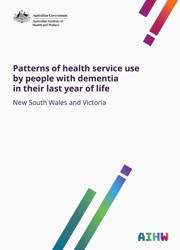Summary
Dementia is a major health issue in Australia. In 2015, dementia was the fourth-leading cause of burden of disease and injury. For those aged 65 and over, it was the second-leading cause (AIHW 2019a). Furthermore, dementia was the second-leading cause of death overall in Australia in 2018 and the leading cause of death among Australian women (ABS 2019).
Dementia is irreversible and as the condition progresses, health and functional ability decline, leading to increasing care needs. Assessing how health services are used by people in their last year of life, and how this may differ for people with dementia, is important for policy development and health service planning and delivery to ensure all Australians receive appropriate care in their final years of life.
This study examined the use of health services by over 70,000 people in the 12 months before their death in 2013 using linked health administrative data. Both the type and quantity of health services were explored and differences between people with and without dementia were investigated. The health services examined included general practitioner (GP) and specialist services; admitted care in a hospital; and emergency department (ED) care, as well as dispensing of prescription medication. Use of aged care services could not be examined in the study.
Results from this study provide a greater understanding of health service use by people with dementia in their final year of life, but further studies are needed to gain a more comprehensive picture of people with dementia in Australia.
Data source and dementia identification
A key strength of this study is the use of linked administrative data in the National Data Linkage Demonstration Project (NDLDP). This database contains de-identified hospitalisation data from New South Wales and Victoria linked to data from the Medicare Benefits Schedule (MBS) and Pharmaceutical Benefits Scheme (PBS) between July 2010 and June 2015, as well as data from the National Death Index between July 2010 and December 2015. The reference year 2013 was selected as the year of death in this study due to issues with incomplete data in later years.
Analysing linked health administrative data is essential to assess health service utilisation in the last year of life and to identify people with dementia. The number of people identified is greatly increased using linked data as dementia is often under-recorded in administrative data, and not every person with dementia uses each health service in which dementia can be identified. In this study, a person with dementia was identified in the NDLDP database if dementia was recorded on their death certificate, as a diagnosis in any hospital admission between July 2010 and their death, or if they had 1 or more prescriptions for a dementia-specific medication between July 2010 and their death.
Of the people who died in 2013 aged 65 or over with dementia evident in the NDLDP database:
- 67% had dementia recorded on their death certificate
- 66% had dementia recorded in an episode of admitted patient care
- 20% had been prescribed a dementia-specific medication.
Only 36% of people with dementia had dementia recorded in a hospital admission and on their death certificate, and just 8% had dementia evident in all 3 data sources. This is in part because dementia-specific medication is currently subsidised under the PBS only for people diagnosed with Alzheimer’s disease. However, these figures reflect the inconsistency in dementia diagnoses coding in health administrative data and the benefits of linking data sets for dementia identification.
1 Introduction
- How does dementia affect health service use?
- Study aims
- Report structure
2 Methods
3 Profile of study populations
4 Overview of health service usage
- Health service usage in the last year of life
5 General practitioner and specialist services
- General practitioner services
- Specialist services
6 Prescriptions dispensed
7 Hospital services
- Hospitalisations
- Emergency department presentations
8 Health service use in people with younger-onset dementia
- Younger-onset dementia profile
- Health service usage in last year of life
9 Discussion
- Key findings
- Strengths, data gaps and future directions
Appendixes:
Appendix A: Detailed methods
Appendix B: Additional tables
End matter: Acknowledgments; Abbreviations; References; List of tables; List of figures; Related publications



